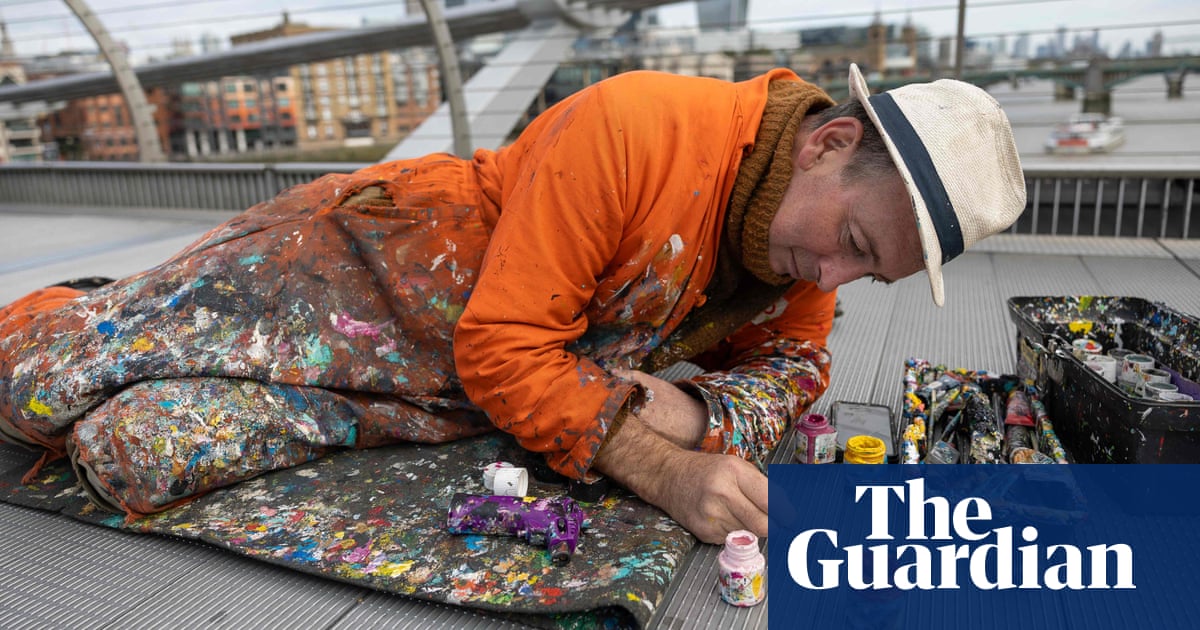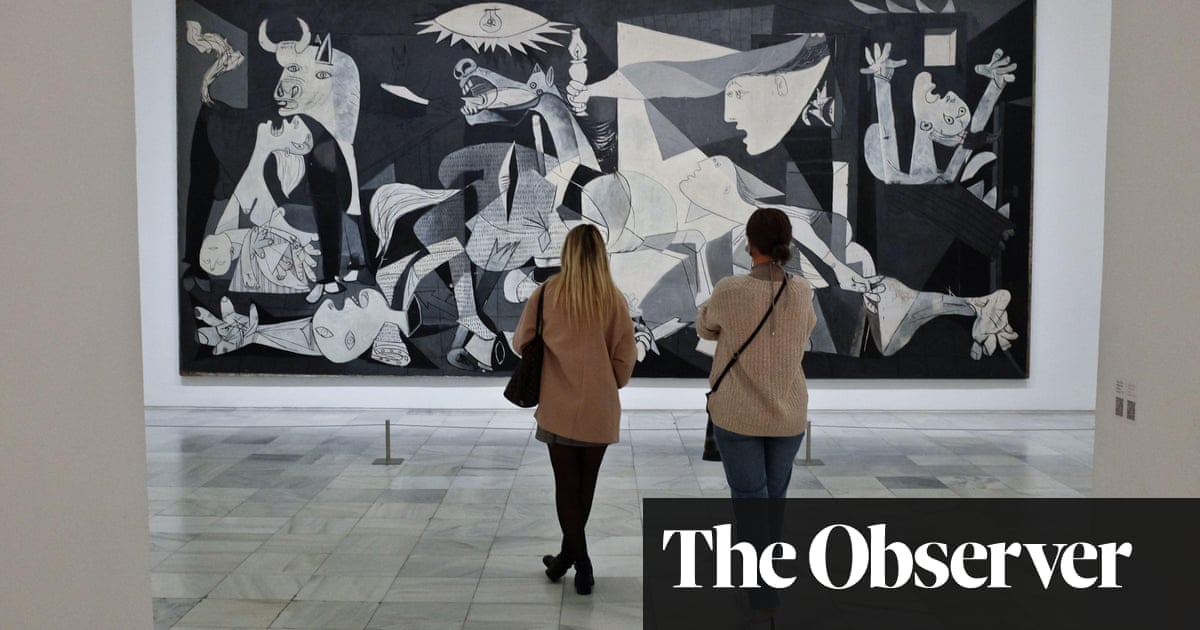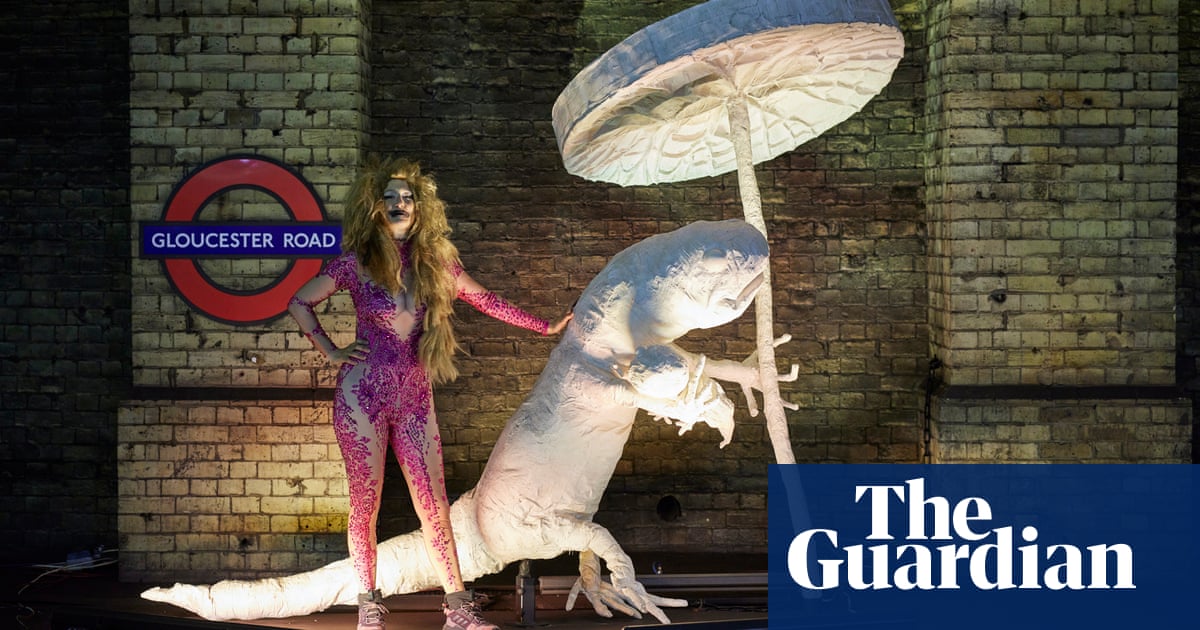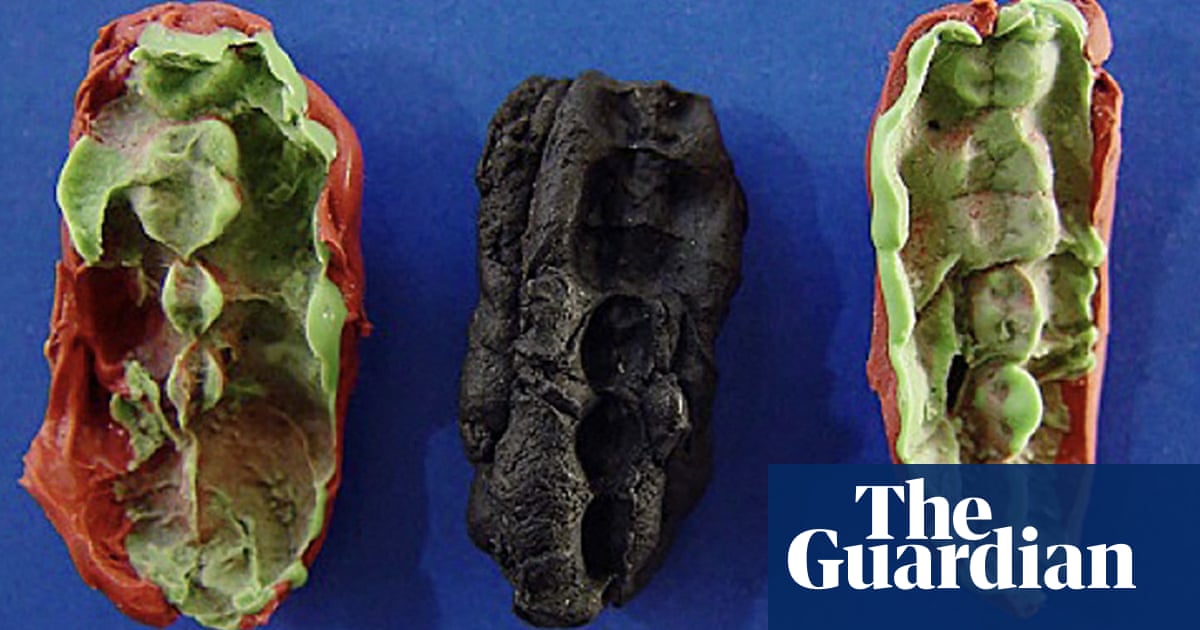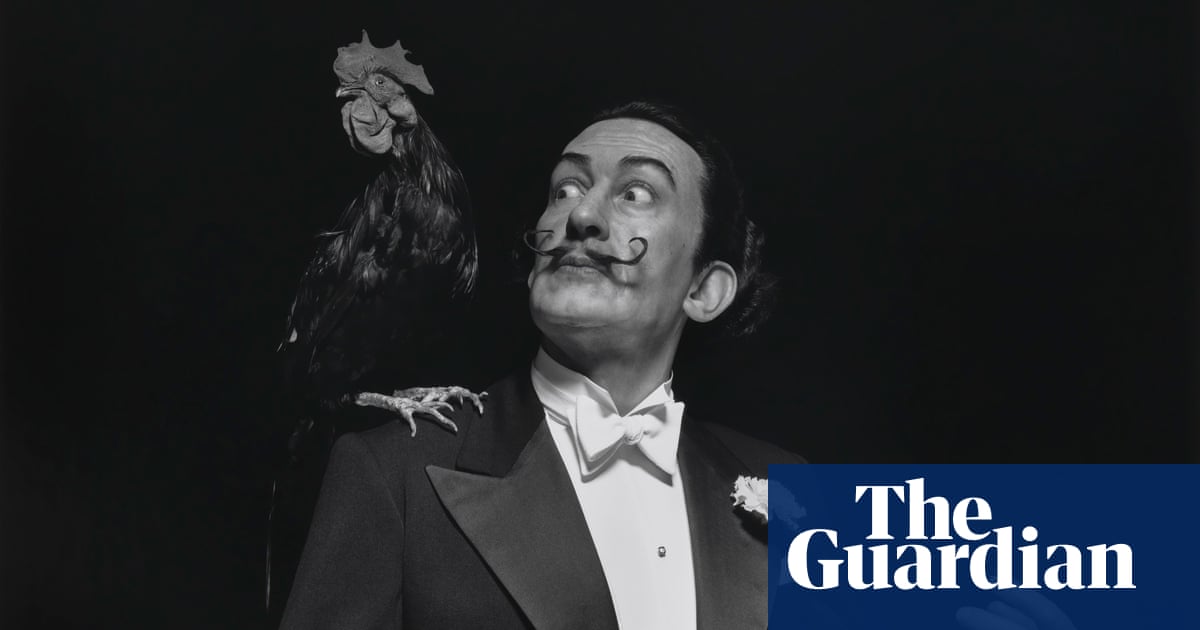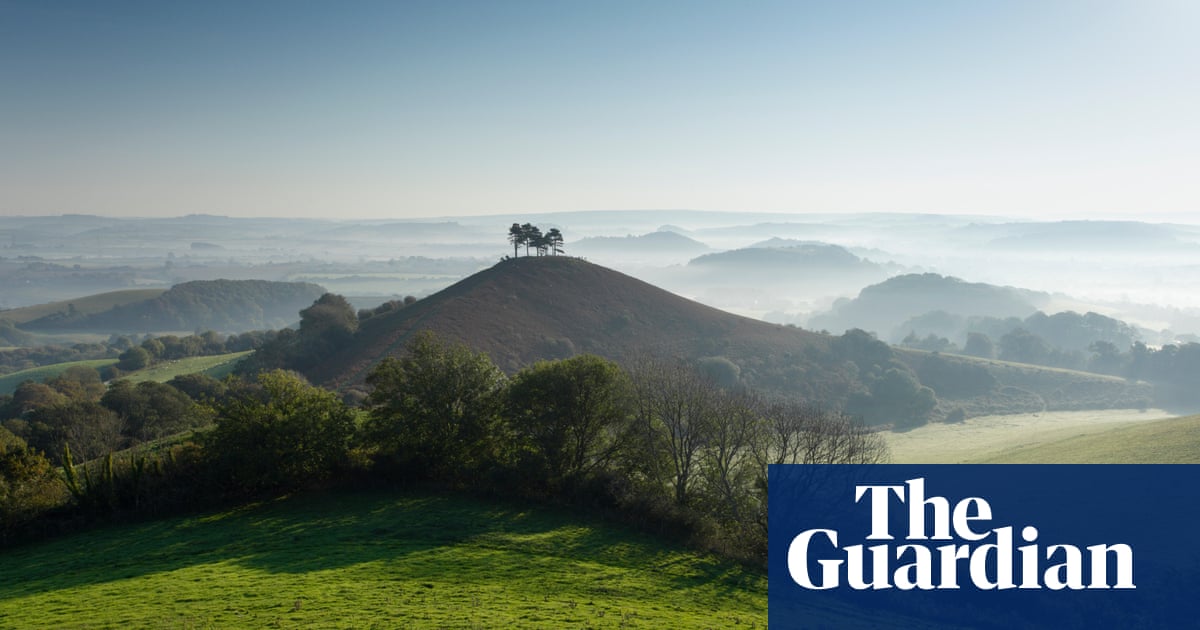
There have been a few times over the past 10 years or so when, feeling as grey as London skies and walking with eyes down to the pavement, I’ve spotted a hard little dazzle of primary colour and felt immediately cheered. Those little spots of intricate brightness are the work of the city’s “chewing gum artist” Ben Wilson, who, since 2004, has spent most days painting whimsical miniatures on some of the millions of flattened blobs of gum that are spat out on the city’s paving stones. Each of Wilson’s paintings is unique; most are dedicated to passersby who ask him to celebrate friendships, or to memorialise lost loves, or just to say “I live here”. I don’t know how you would measure such things, but it’s my hunch that no living artist gives more tiny moments of delight or comfort to a greater number of Londoners on a daily basis than Wilson.
I got talking to him back in 2005 and he ended up doing a painting for my young daughters. In the years that followed it was a little secret they shared with their high street, and a cause of tears one day when they discovered “their” paving stone had been pulled up and replaced. Since then, Wilson has made several thousands of these pictures; he keeps a photographic record of them and most of their dedicatees, goes back and carefully touches up those that have been scuffed or damaged. The result, for those who know where and how to look, is a kind of alternative trail of blue (and green and yellow and red) plaques, not to the famous dead but to the diversity of the living city.
Sometimes, if you are lucky, you might catch Wilson in the act of making his art. He has regular haunts, the Edwardian streets around Muswell Hill and Crouch End near where he lives, favourite corners of the older city in Shoreditch and Hackney, and the Millennium Bridge, where he has done a series of trails of hundreds of chewing gum paintings that have ended up with surreptitious artistic invasions of the Turbine Hall at Tate Modern. I caught up with Wilson, now 58, one morning last week in Muswell Hill, where he was renovating some pictures outside the Everyman cinema. A tall man, with an irrepressible grin, he was wearing, as ever, bright orange industrial overalls decorated with layers of paint and lying flat out on the pavement on a piece of thick matting that he carries rolled up in a rucksack, along with his toolbox of materials.
The technique is very precise. He first softens the oval of flattened gum a little with a blowtorch, sprays it with lacquer and then applies three coats of acrylic enamel, usually to a design from his latest book of requests that come from people who stop and crouch and talk. He uses tiny modellers’ brushes, quick-drying his work with a lighter flame as he goes along, and then seals it with more lacquer. Each painting takes a few hours and can last for many years.
Wilson’s eccentric acts of daily creation make more sense the more he explains them. He is energetically interested in the threatened idea of public space. Technically, in painting gum – as he has established in the courts – he is not painting public property or commercially owned real estate. His pictures are designed to create a tiny stepping-stone mosaic of common land across the city. Gum, he suggests, is the ultimate consumer product: it has no food value at all, it hardly biodegrades, and attempting to remove it is a costly and laborious full-time job. “So there is some symbolism in transforming something thoughtlessly spat out into something meaningful.”
Beyond that principle, Wilson is interested in cheerfully modelling an idea of intimate local connection, celebrating community. Outside the Everyman he is cleaning and touching up a picture that shows in tiny detail a murmuration of starlings over Brighton Pier. “I always felt bad about this one,” he says. “It was on my list to do, but the man who had asked for it sadly died before I’d got to it. I happened to get talking to his son in a cafe near here, and he asked if I might do it in memory of his dad, who really liked those murmurations, so at least I was able to do that. And he loves the picture.”
He cleans it up meticulously, adding a little paint to the edge where it has been damaged. He then talks me through some of the others by the nearby kerbsides. “This is for a man I see around here – Ivan – he wanted Ivan the Terrible, so I did that.” We walk over the road to a row of shops. He cleans up a picture outside the local Ryman, reads its inscription: “This is for Nadia, who worked here.” Outside the post office, there is a tiger in honour of a postal worker who is from Sri Lanka. To mark the closing of the Woolworths a couple of years ago, Wilson managed to fit every redundant employee’s name on to a piece of gum as a lasting reminder.
While we walk he is frequently stopped by people for whom he has made paintings. Rose, the Big Issue seller outside Sainsbury’s, is an old friend. “Rose and I have a good working relationship,” he says, “she watches my stuff if I need a loo break, and I watch hers.” A man called Ahmed Garrad, a painter and decorator, greets Wilson with a broad smile. He explains to me how Ben made a picture for him in 2014 when he had returned to Britain from his original home in Syria, during the civil war. He and his three children had British passports, but it took him nearly three years, battling with the Home Office, to bring them and his wife over to join him. Wilson had painted him the Syrian flag, the symbols of the Free Syrian Army and the names of his children. It was a nice little badge of hope for Garrad during his legal battles, he says, one he was eventually able to show to his family when they arrived. “The longer I lie here, all sorts of situations will unfold,” Wilson says, restoring a picture of a pigeon. A gruff man peers over his shoulder. “In Singapore they’d cut your hands off for doing that,” he says. “I don’t think they would,” Wilson murmurs. A woman stops with her granddaughter in a buggy and explains how Wilson made a painting for her daughter when she wasn’t much older than the baby. “You make Muswell Hill,” she tells him.
During lockdown he worked when he could; he had Covid early on, and then gave blood for antibody treatments. He’d been invited to do a series of gum pictures along the Parkland Walk – a narrow ribbon of woodland that was once a railway line through north London – and though a promise of council funding for the project fell through, he did it anyway. We walk along a section and he shows me some of the paintings that can be followed with a geolocation map – a rescue dog called Peggy, a ghost station from the original railway, a jogger in a glade of light, each with a minute inscription. “If people feel isolated, as they did so much in the last year, a painting gives them a point of reference,” Wilson says. “It says: this is your environment. Once you get that idea, then anything is possible.”
Wilson lives where you might imagine him to live, in the ground-floor flat of a rambling Victorian villa, with an antique Pashley bike in the hallway and his art – canvases and painted tiles and photographs – piled on every available table and surface and stacked against every wall. Outside in the back garden there are monumental wooden sculptures that rise out of the undergrowth; the biggest – which Wilson made as a kind of goddess spirit of place, out of scrap timber – is 15ft tall.
In one corner of a tiny sitting room are shelves of battered notebooks where Wilson has jotted down gum picture requests over the years like a shorthand births, deaths and marriages column. Thumbing through them, he seems on the verge of tears. “I’ve had to deal with people memorialising people who have been murdered,” he says. “People who have been so lonely, or remembering favourite pets; people who are destitute in all sorts of ways. It goes from proposal pictures, ‘Will you marry me?’, to people who I drew when they were kids and they now have their own kids.” He likes how everyone has a picture in their head: “Some want cheese and crackers, or nicknames. Easter Island statues. English breakfasts…”
If he has an inspiration it is Henry Mayhew’s Victorian encyclopaedia of people on the margins of society, London Labour and the London Poor. “Right at the beginning of doing the pictures, I came across the original three volumes of it in a charity shop in Archway,” he says. “It felt like a sign to carry on.”
Sometimes, people who see him lying out on the street imagine he is passed out, drunk; ambulances have blared to a halt beside him. He has been wrongfully arrested a couple of times. He is still traumatised by the manner of his arrest in 2010, when he was working on the Millennium Bridge. “I was doing a picture of St Paul’s for some school kids who were really excited,” he says. “The police arrived and tried to arrest me for criminal damage and I asked if I could just finish the picture. They pulled me along the bridge by my feet, threw me in a cell, and took my DNA, taken by force.”
Wilson won his case in the City of London magistrates court, with the help of letters from supporters. One was from John Maizels, publisher of the art magazine Raw Vision, which has featured Wilson’s work many times. “Ben Wilson is an artist with tremendous commitment and integrity,” Maizels wrote. Penny Northway, meanwhile, the children’s minister at a Muswell Hill church, told how Wilson painted a gum picture for her son, Max, in memory of his grandfather. “My respect for him grew after I noted how sensitively and patiently he dealt with Max and translated his (slightly muddled) wishes into a pocket-sized painting,” she said.
These days when he works on the bridge, Wilson carries with him a letter from his local police force explaining his work. He has done two trails across the bridge (the first was painstakingly removed by teams of cleaners). “It’s funny,” he says, “Tate Modern is pretty much the only institution I’ve worked outside where someone has not brought me out a cup of tea and had a chat.” He Blu-Tacked a hidden sequence of gum pictures inside the gallery when he completed a trail, and invited friends to the “opening”. “I met a curator and invited her along, but she just laughed in my face and said, ‘I know who you are!’” Wilson thought: “Actually, you don’t really.”
Over the years, he has been called an environmental artist or an outsider artist, but he’s mostly allergic to labelling. That spirit started early. He was brought up in Barnet, he says, in “the spirit of dadaism”. His father was a ceramicist who did experimental theatre as a member of Jeff Nuttall’s radical 1960s collective People Show. His mother was an illustrator who once had tea with Salvador Dalí. “I was working with clay from about the age of two,” he says. “I remember when I was about 11, at my junior school, being thrown out of the class for doing pottery wrong.” That idea hadn’t occurred to him before. He was saved at his comprehensive school by art and English teachers; he was offered a place to study art at Goldsmiths but decided to go his own way.
His work first came to public attention in the mid-1980s, when he secretly made a series of wood sculptures, including a vast sleeping giant, in Hadley Wood, near to where he grew up. The wood came from a beech tree that had been smashed by lightning and brought down two hornbeams. Wilson made the prone sculpture by weaving the fallen branches, working when it was raining, or at night. “This whole sleeping figure arose,” he says. “There were newspaper and radio reports, but no one knew who did it.” He left the giant for two or three years, then late one night dismantled it, leaving no trace.
From there, he made different kinds of “sculptural environments” in woodland in Canada and New Zealand. He shows me pictures of an elaborate wooden shrine he made to the spirit of free foxes, next to a high fence surrounding one of Finland’s intensive fox farms. He was commissioned to work at LeHigh University in Bethlehem, Pennsylvania, but a mix-up in paperwork led to him being deported, a fact that still prevents him going to the United States.
Wilson has always refused to take any money for his gum pictures, because it seems against the spirit of them, though he is thinking of letting people give a donation if they can afford it. Though he lives on his own now, he has three children in their 20s, pictures of whom are on his walls among his art. How, I wonder, has he supported himself, working long days on the streets?
“It’s been really hard,” he says. “I have sold other work in galleries – [he recently had a show at the Hoxton Gallery in east London]. I’ve been commissioned to do trails in different cities – Zürich, Brussels, Amsterdam. I have done loads of workshops with schools.” He has lately developed a technique where he melted the gum pictures on to a house brick so people can buy them. “I feel certain organisations could help with funding,” he says. “But they never do.” As it is, he worries constantly about how he will pay the rent on his flat. Even so, he plans to carry on with his never-ending trail until he can no longer lie down. He flicks through a book of photographs of his pictures, recalling their stories. “This one was for an amazing woman who runs a charity for children rescued from fire in South African townships.” He peers at another inscription above a pictured handshake: “To the common unfolding humanity who cross this bridge,” he reads, and smiles. “I liked that line.”




